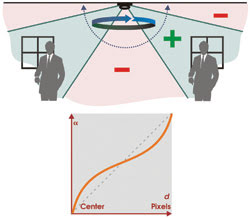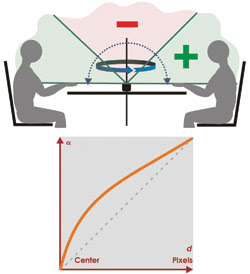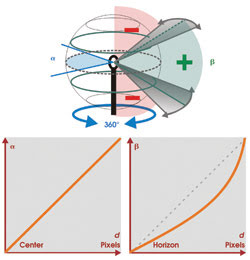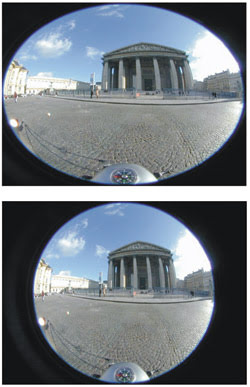Managing distortion and pixel coverage is an innovative approach to digital imagery that can significantly improve new or existing imaging systems.
Dr. Simon Thibault, Institut National d'Optique
To the human eye, distortions of less than a few percent typically are not visible. In precision digital imaging applications, however, even a small degree of optical distortion can result in significant losses in resolution.
Distortion management offers a new degree of freedom for optical designers. With some imagination, the qualified specialist can design optical systems that enhance the performance of digital imaging systems. By controlling distortion, the relation between the field of view and the pixels may be optimized for any given application.
A simple expression states that distortion is a transverse deformation of an image. For example, if a grid is used as an object, its image in a system with distortion will be a grid of curved lines. Distortion is the result of the change in the transverse magnification in the system as a function of the distance from the optical axis. When the magnification decreases as the distance from the axis increases, it produces a barrel-shaped image. Conversely, when the magnification increases with distance, a pincushion image is obtained.
Managing distortion of any type involves questioning the assumptions made at the beginning of the design process. Examples of optical design that account for distortion include the f-Theta lens in laser scanning systems, which produces a constant scan velocity across the image plane, and the reversed telephoto, or retrofocus, lens.
In the case of barrel distortion, for instance, instead of trying to remove it, one can increase it to such an extent that the image height is proportional to the field angle itself rather than to its tangent. This results in the fish-eye lens.
The designed distortion of the fish-eye lens remains a departure from the ideal linear function between the field angle and the pixel coverage, however. This produces a reduction in the resolution (pixels per degree) of the scene under study. That reduction can be as large as 15 to 20 percent, which corresponds to a penalty of more than 150 to 200 pixels in the case of a 1-megapixel linear sensor. This is a huge number of pixels that cannot be used for detection, recognition or identification.

Figure 1. A camera is mounted on the ceiling in an indoor video surveillance application. The chart shows the pixel coverage obtained by proper distortion control. The dashed line represents the pixel coverage for an ideal fish-eye lens, which is constant with the field angle.
For the video surveillance of indoor parking garages, offices, stores and houses, a camera usually is mounted to the ceiling, with its lens facing down (Figure 1). The most significant — and, often, distant — objects are in the zone at the periphery of the lens. This part of the picture is the most important because it enables facial recognition.
To maximize the optical performance, the lens may be designed to increase the picture resolution in this particular zone. By controlling the slope of the distortion profile, a section is viewed in higher resolution. An improvement in resolution by a factor of two may be achieved compared with a fish-eye lens.
Videoconferencing
Other interesting applications also can benefit from distortion control. To make videoconferencing as efficient as a face-to-face meeting, a similar camera may be placed on a table. In this case, its lens faces up (Figure 2). Again, the distortion profile of the lens will help to increase the resolution where the heads of the people normally are positioned relative to the camera.

Figure 2. In a videoconferencing setup, resolution on the periphery also should be increased. The chart below shows the pixel coverage after distortion control. The dashed line represents the pixel coverage for an ideal fish-eye lens.
In contrast, some wide-angle lens applications may require that the resolution be higher in the area directly in front of the lens. One example is surveillance around automated teller machines for banking. For this purpose, it is important to record what happens around the machine to improve the efficiency of security, but the most vital information is in front of the camera — again because it enables recognition. A wide-angle lens with greater resolution in the center is suitable for this purpose.
Such a lens also could be employed in a mobile phone, allowing an individual to use the device to participate in a videoconference. The wide-angle feature would enable the user to be always in the field of view of the camera.
For most outdoor surveillance scenarios — for example in a 360° video system — fish-eye lenses are widely used. However, a horizon-increased resolution distortion profile would improve the resolution by up to three times compared with a fish-eye lens (Figure 3). Such improvements in imaging system efficiency would help to reduce the pressure on the surveillance software.

Figure 3. In an outdoor surveillance system, the camera moves 360°. A threefold resolution increase over a fish-eye lens can be expected in the green zone. The chart on the far right shows the pixel coverage after distortion control. The dashed line represents the pixel coverage for an ideal fish-eye lens.
Although the choice of the distortion profile may be complex, the factors that must be taken into account are relatively straightforward: application, minimum acceptable resolution and cost. These are interdependent. Other factors, such as wavelength range, light level and environment, also must be considered.
Managing pixel coverage
Improving the optical resolution across the field of view can be beneficial in a surveillance system. Distortion control can reduce pressure on the software; however, other ways exist to raise the resolution.
It is well known that the fish-eye lens provides a circular image (Figure 4). Used with a standard CCD or CMOS format, the circular footprint underutilizes the available pixels on the sensor. By improving the pixel coverage with an elliptically shaped footprint of the picture, we have achieved significant optical improvements compared with the standard fish-eye lenses.

Figure 4. Images taken with a fish-eye lens show improved pixel coverage with an elliptically shaped footprint (top) and a circular one that underutilizes the available pixels on the sensor (bottom).
In a standard 4:3 format sensor, up to 30 percent more pixels are covered by the picture on the horizontal axis. Elliptically shaped pictures are obtained by an anamorphic optical design, which means that the focal length is not the same for the X (horizontal) and the Y (vertical) axes. This wide-angle-lens family can be used for digital-imaging applications that already use fish-eye lenses, with a real improvement in pixel coverage.
Meet the author
Simon Thibault is an optical design program manager at Institut National d’Optique in Quebec City; e-mail: simon.thibault@ino.caESS.